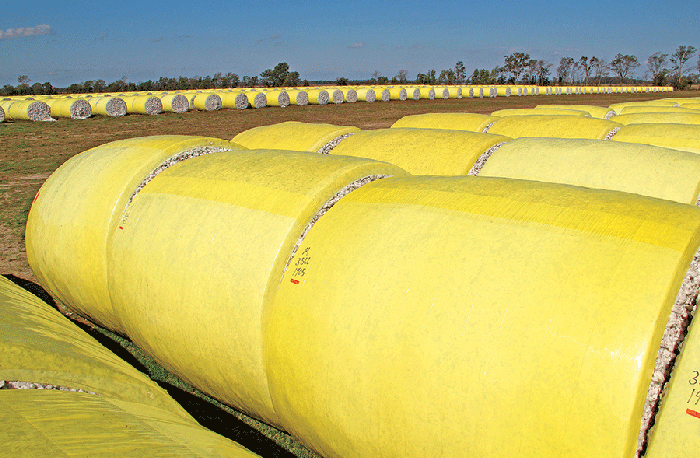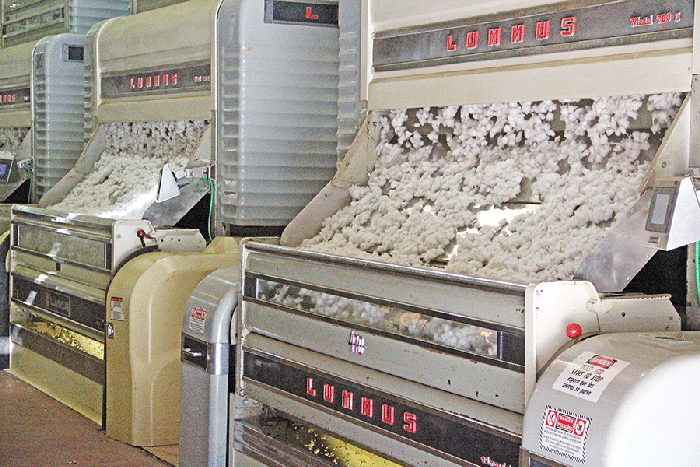
Higher prices could be ahead for cotton, says Dr. O. A. Cleveland, Jr., because there’s a lot of demand for high quality cotton and supply is shrinking. On the other hand, increased plantings in the U.S. and major growing countries, coupled with favorable weather, could result in more production, increased carryover, and lower prices.
“The real key now is what Mother Nature gives us over the next several weeks — that will be the key deciding factor in how the market reacts,” the Mississippi State University Extension professor emeritus said at the joint annual meeting of the Mississippi Boll Weevil Management Corporation and the Mississippi Farm Bureau Federation Cotton Policy Committee.
“We can still take this market to 75 cents, or we can take December down to 60 cents. In the short term, there’s just that much variability hinging on the weather. Weather is controlling the market, and depending on what it does, the signal can be bearish or bullish.

“We can still take this market to 75 cents, or we can take December down to 60 cents," says cotton analyst O.A. Cleveland, Jr. "In the short term, weather will be controlling the market, and depending on what it does, the signal can be bearish or bullish.
“Looking at the U.S. crop a week ago (early July), I wrote that the crop may have turned the corner, with the potential to get the market back up to 69 cents, or maybe even higher, depending on the weather. That weekend, West Texas got great rains, there were rains in all the dry areas of the Southeast states, and the monsoon in India helped all the areas that were suffering there. So, just in one weekend the market went back to focusing on the supply side and a potentially big crop.”
See a video of Dr. Cleveland talking about the cotton market: http://bit.ly/2v38avt
After positing a crop that “could drop as low as 18 million to 18.3 million bales,” Cleveland says, “now I’m back much closer to 19 million. But it’s only early July, and anything can still happen with this crop. In 1991, this same week in July, (cotton analyst) Ed Jernigan and I looked at the crop. It was calf-high, weeds were higher than the cotton ��— an absolutely horrible-looking crop. We wrote it off. It turned out that 1991 was a record yield in Mississippi.”
COTTON MARKET NOW INVERTED
The moral of the story, he says: “We could still have a record yield this year. It all depends on whatever Mother Nature deals us from here on out. I could tell you I really think cotton’s going to 70 cents-74 cents, as opposed to a low of 60 cents. But there is still a huge price range that is totally dependent on what Mother Nature gives us for at least another month, and things can get even dicier after that.”
The cotton market is presently inverted, Cleveland says, “meaning that cotton is more precious today than in March, May, or July, and more precious for October and December delivery. That reflects the exceptionally strong demand we’re seeing right now. We have sold approximately 1 million more bales than we have in inventory. Consequently, we’ve got to get a million bales harvested and ginned and ready to deliver by December, or else we can’t make those sales.

The cotton market is presently inverted, says O.A. Cleveland, Jr., “meaning that cotton is more precious today than in March, May, or July, and more precious for October and December delivery. That reflects the exceptionally strong demand we’re seeing right now."
“We’ll get it done, but how close will it be filling that demand? The market is telling us we’re gong to stay high right now relative to the back end of the market, because we’ve got a strong future commitment that we’re going to have to meet. This inverted situation will probably stay with us through late November/December.”
The International Cotton Advisory Committee is suggesting that “we’re getting ready to see a nine-year low in cotton prices, down to 60 cents to 63 cents,” Cleveland says. “I can’t go along with that. They’re basing that prediction on a normal crop, but I contend we’re in a weather market and we’ll see some problems that can move price.”
Managed commodity funds were 150,000 contracts long around the first of May, he says, ut today they’re long only about 30,000 contracts. The managed funds and speculators have got totally out of cotton. We don’t have any speculative money in cotton right now, and that’s where the capital investment comes from to push prices higher. Without them, we get bearish markets, and that’s what the funds and speculators are anticipating.”
POTENTIALLY GOOD BASIS
At the Beltwide Cotton Conferences in January, when cotton was 73 cents, Cleveland says, “I was extremely aggressive in suggesting that producers should consider selling at least one-fourth of their crop. As the price went to 75 cents, I said, sell all of it — get rid of all your 2017 crop. The price almost hit 76 cents a time or two, and some were waiting to try and get that additional penny. But you can lose 10 cents waiting for another penny. I was so concerned, I said if you don’t want to sell, at least go out and buy puts as close to 75 cents as you’re willing to risk. Or if you want to speculate, sell your entire crop at 75 cents and buy puts too, because I think it’s going to pay off both ways.”
The market has had a June low, Cleveland says, “which is typically followed by an August high. I would anticipate that we would see a higher price in August, assuming Mother Nature doesn’t give us gravy every single day between now and then. More importantly, based on our export sales, as we get into our harvest and get closer and closer to December, we should see some very aggressive basis offers.

"Based on our export sales, as we get into harvest and get closer and closer to December, we should see some very aggressive basis offers," says cotton analyst O.A. Cleveland, Jr.
“Cotton is much more desirable today, and it will be even more desirable in August than today. We should see some very handsome offers, basis the December contract, as we get closer to the first notice day of December. In all likelihood, that would be a good time to price, based on what we see now.
“I’m going to assume we’ll have a normal growing season, and that we’re not going to get a record crop. Most of the Texas growing areas that were suffering now have moisture, and their crop is coming on strong. Based on that, I would tend to think we’ll scare the death out of 64 cents to 65 cents for December. If we don’t continue to get the moisture we need, it could get back up to 72 cents to 73 cents.”
COTTON EXPORTS ‘ABSOLUTELY PHENOMENAL’
The big negative this year is increased world plantings, Cleveland says. “We were expecting something like a 7 million bale increase in world carryover due to the significant increase in plantings, including major increases in the U.S., India, and China, and smaller bumps in other countries. With increased plantings and the assumption of normal weather, the expectation is for an increase in production.”
On the bullish side, he says, “cotton export sales have been absolutely phenomenal. This year ranks No.3 in the largest amount of export sales for the coming season that we’ve had since 1990. We’ve sold forward about 4.5 million to 4.6 million bales for the Aug. 1, 2017-July 31, 2018 marketing season, so exports should be extremely strong again next season.

China “is buying our cotton out the wazoo," says O.A. Cleveland, Jr. "They can’t get enough U.S. cotton, and they will continue to buy it."
“Why are we selling so much cotton for export? U.S. growths are better priced than any other cotton in the world right now for delivery in 2017/2018.”
China, Cleveland says, “is buying our cotton out the wazoo. They can’t get enough U.S. cotton, and they will continue to buy it. They’ve taken their huge reserves down to about 30 million bales. It’s the first time since 2010/2011 that their reserves haven’t comprised more than 50 percent of world carryover. Their reserve sales are going gangbusters.
If we look closely at the data, anytime they have Xiangyang cotton for sale, they sell it all. If it’s not Xiangyang, if it’s eastern China cotton, it doesn’t sell. What this tells us is that the Chinese want high quality. If they can’t get Xiangyang and have to buy Chinese low quality, then they have to import more and more quality otton from the U.S., Australia, and Brazil to mix with their low quality fiber.
STRONGER DEMAND BY MILLS
This tells us that Chinese mills are very hungry, their yarn stocks are not increasing, and that whatever they’re spinning they’re selling. The result is that we’re seeing a stronger demand base in China than had been anticipated. Sooner or later, I think the USDA will adjust their data to reflect this stronger Chinese demand. If we look at U.S. sales on a week-by-week basis, China is there. Last week they bought 100,000 bales, the week before that approximately 45,000 bales. It’s a strong upward trend, and they will continue to buy U.S. cotton.”
The much bigger cotton crop in India has made a turnaround, Cleveland says. “For three years they’ve had poor monsoons, and this year’s monsoon was slow to come. But last weekend they got moisture, and their merchants say the crop is growing fine. They’re looking at 32 million to 33 Indian bales (about 75 percent of U.S. bales).”
All things considered, he says, “My bias is for a 10-cent price range, and that good weather will take the market lower. Two of the three largest crops in the world have got needed moisture, which makes me a little concerned about the market. But I think you should have a handsome basis alternative as we get closer to harvest.”
Cleveland noted that growers are welcome to listen in on the monthly cotton marketing teleconference featuring him; Kipp Butts, Informa Economics cotton and energy specialist; and Gerald Neeper, Calcot Ltd. chief executive officer. It is held the day after the USDA’s monthly Cotton Supply-Demand Report and can be accessed online at http://agmarketnetwork.net, or by phone at 712/775-7085 (punch in access code 969119 after dialing in). There is no charge.
About the Author(s)
You May Also Like




